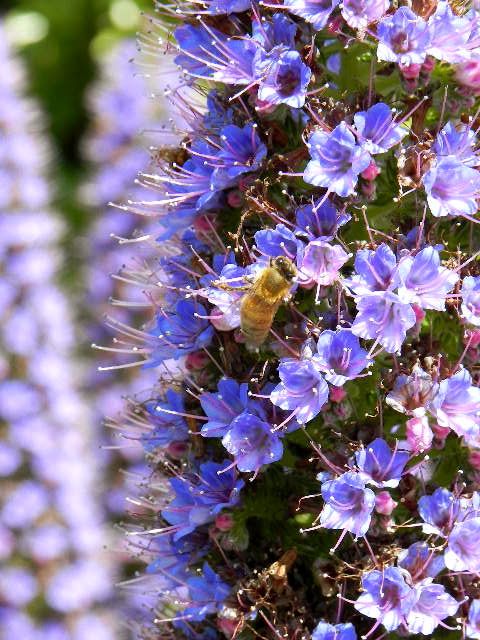
Everywhere that I’ve lived, there has been at least one insect that I find especially annoying. In Marin and Sonoma Counties I despised the yellow jacket, often called “meat bees”. Those little monsters, similar in appearance to the sweet honeybee, would spoil every picnic we had and sting us for no apparent reason. Yellow jackets, a member of the wasp family, are beneficial in that are scavengers, eating rotting meat and decaying fruit but humans beware! They can ruin and bar-b-que in minutes.
In San Luis County, the most annoying of pests to local gardeners is the innocent looking spotted beetle but that looks like a green ladybug. The Western Spotted Cucumber Beetle (Diabrotica undecimpunctata) is often mistaken for our beloved “ladybug” or “lady beetle” (Coccinella septempunctata). The two bugs are not related although they are the same size and shape. The ladybug is red with black spots. It is considered a “beneficial insect” because it eats aphids and other unwelcome soft-bodied sucking insects. Ladybugs lay eggs on the underside of leaves. Their larvae (a black and orange fuzzy creature) has an even greater appetite for “bad” bugs. Be sure you are careful with spraying and “let these critters do their job”.
The dreaded spotted cucumber beetle is green, or greenish-yellow, with black spots. Unlike its “lady” look-alike, the cucumber beetle has no redeeming qualities. Instead of eating the aphids on roses, the cucumber beetle eats the rose blossom itself. It can devour an African daisy, a poppy, or a lily in a day. It loves anything yellow like squash blossoms, calendula, coreopsis, and most things green. The cucumber beetle has no predators except birds.

There are a few things you can do to “lessen” the impact that these little insect have in your garden. Understanding their life cycle will help you to do this. Unlike the ladybug, the cucumber beetle can overwinter in the soil under plants. Cleaning up in the fall and cultivating the soil around trees and shrubs will help rid your garden of the hibernating beetles and their eggs. In the larvae stage they chew on the underground roots of plants. When they hatch in early spring, you must go into full attack. In our climate, the adult beetles can create several generations during a season. Reducing the number of beetles early will help control the population.
Some organic methods of beetle control are:
- Patrol the garden in the early morning. Carry a small container of soapy water and knock bugs into the bucket.
- Spread onion or garlic skins on the soil around planted areas.
- Make a basin 3″ deep around plants. Fill with wood ashes and moisten.
- Heavy mulching deters cucumber beetles from laying eggs in the ground.
- Cultivate the ground in the fall to expose the eggs.
- Poison sprays will affect beneficial insects like bees and ladybugs so I don’t recommend them.
I have seen damage decrease if I patrol with my trusty soapy bucket a few times a week. When I see a cucumber beetle, I tap the flower or leaf it is sitting on and it falls into the soapy water below. It gives me, ordinarily a lover of all living things, great satisfaction in knocking those annoying critters off my beautiful flowers and into their sudsy doom.



Thank you so much for the tips, they have been ravaging all of my squash and gave my sunflowers a week long bloom cycle this year in Missouri (the massive drought has not helped either), and have not found many resources for the simple control of these pests. Everyone has been telling me poison them but I do not feel comfortable with that. They also like to spend time on my many varieties of tomatoes and was wondering if they are destructive to those plants as well.
My partner was bitten by this insect and it left a lump type mark .is this common?
lol. i had actually been “saving” these cute little lady bug look alikes! but, when they were all over my lettuce we grew in cayucos and then were still alive in the bag i brought home to san diego, i started thinking maybe they were baaaaaadddd.. thanks for the info! will be saving my onion peels.
I too thought these were good bugs when I began gardening in Marin County twenty years ago. They didn’t seem as destructive there. Perhaps the chilly winters were killing them off. Here in Cambria they can destroy blossoms on an oriental poppy in a day!
I’ve not heard of them biting. Then again, they are beetles and do have chewing mouth parts. Now I dislike them even more!
I just caught one this morning. I had to bring my bell peppers in because the temps here dropped 20 degrees and I have 3 more fat ones growing. Put it in a bug container for my toddler to look at. Pretty sure I may see a few more of these little critters before the week is out.
I was out watering this morning and the beetles were flying up all around me. I guess there was another hatch during the last few days of a heat wave. It was over 90 in our coastal town. Very unusual weather. These cucumber beetles are usually gone by this time in a normal year. We need a good freeze this winter to kill them off.
Thank you for the info! This is the first year I have had problems with them! There are hundreds on my dahlias eating all the pedals… what kind of spray should I purchase to KILL THESE BUGS? HELP!
Ellie, glad you found the article helpful. I don’t recommend commercial insect sprays. When they are used, they kill all the beneficial bugs that keep your garden in balance. About the only way to control these insects is to knock them off into a bucket of soapy water or to use my home-made insect spray to kill them. It really helps to treat them (in other words kill them) every day for a bit. Keeps their numbers down which is all you can hope for. Good luck!
I found one in my house. We don’t have plants but my apartment has grass all over the front and back. Is this poisonous? Do I need to call the exterminator? Should I be worried?
I have been very frustrated for the last several years when my crop of tomatoes and peppers has dwindled considerably. I knew theire was something eating the blossoms but could not discover what it was. This fall I discovered on my fall mums (yearly) these green and black spotted beetles. I quickly checked the Internet to see what they were. Cucumber beetles. I have spent two days several times a day and still am catching them. When do they lay their eggs and how much time do I have to keep catching them before this happens? Do you think they are what is eating my blossoms? I noticed the blossoms of the mums are being stripped .
Thanks
Nancy from central Pa
Hi Nancy. If the small beetle (green with black spots) shaped like a ladybug is on your plants and blossoms, it is most likely a Western spotted cucumber beetle. I see you live in Pennsylvania so my advice is to search your Pennsylvania Universities websites and/or take one in to your county Agriculture office to see what they say. Perhaps they have a Master Gardeners information desk where you can get advice on controlling these very unwelcome insects.
Now here’s my two cents. The beetle lays eggs in the soil under your plants. The larva lives there and actually feeds on the roots of plants. When the weather warms it emerges and flies and moves from plant to plant. Along the California Coast, it does not freeze so mulching heavily (4″) is advised to keep down the population. But since you live in an area that freezes, this should kill them, so mulching may not be the answer for you. This is why I’m advising that you look for local advice.
Please let me know what you find out. You are not the only one looking for information on this pesky critter! I’ll pass on what is advised in your area.
Thanks for letting me know that this not just a California garden issue.
Good luck!!!
Just found many of these beetles on my roses and we live in Northern PA. Unlike the Japanese beetles that eat the rose leaves, these were chomping away on the flowers. They were also enjoying what was left of my basil. Thanks for the advice! Now looking forward to the freezing temperatures.
I thought these were more of a western insect but I’m being told they are moving East. Sorry to hear that. They are especially attracted to yellow flowers in my garden. Like you, I’m looking forward to cooler weather where they will go underground.
These things are in my house, all over my pet beds and blankets. Are they dangerous?
My pets are having problems with their ears. Irritation. Can these bugs be the cause?
Are you sure those bugs are the Western spotted cucumber beetles. These spotted beetles eat plants and flowers and I’ve never had them in the house unless they’ve ridden in on a bouquet of flowers. Take a few down to your County Ag department and have them identified. Then’ll you’ll know how to treat them. Poor pets!